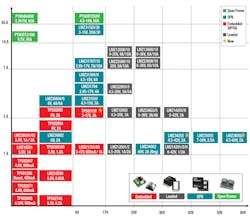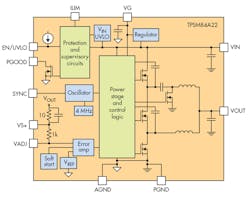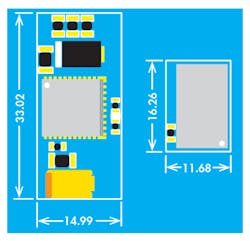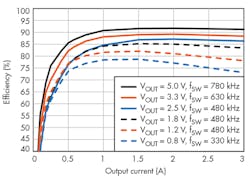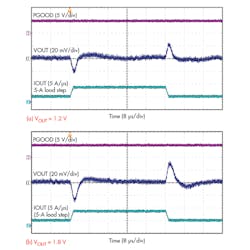Download this article in PDF format.
Those who suffer from AAA (Alliteration Abuse Ailment) are unlikely to be power-system designers. Why? Because designing a power supply is an exacting task, and too often the design is left to the last minute. So the power designer is busy trying to meet an unreasonable schedule and doesn’t have time for such frivolous flights of fancy.
Why Choose a Power Module?
Help is at hand. A power module helps reduce development time because it integrates the controller, the inductor, the power FETs, and many of the passive components into a single package. It tends to have low radiated and conducted emissions and low output noise because the compact design minimizes the trace lengths between internal components and keeps ac current loops small.
A module has a smaller footprint and a lower part count than a discrete design, which lowers manufacturing and inventory costs. On the other hand, a power module’s high level of integration fixes some design parameters that could be fine-tuned in a discrete design.
Figure 1 shows a selection of Texas Instruments power modules. There are four different package types, and many voltage/current combinations have a choice of more than one product.
Power modules come in different integration and power levels. Texas Instruments offers 216 parts, ranging from micro-SIP designs in BGA packages to full open-frame designs that can deliver up to 50 A. Many modules have a fixed-output voltage and require no external components.
Figure 2 shows one of the newest products—the TPSM84A22, a highly integrated, synchronous, step-down 10-A power module that includes both input and output capacitors. A complete solution requires only one external resistor to set the output voltage, which can range from 1.2 to 2.05 V with a 12-V input.
The TPSM8A22 is a member of the SWIFT family of dc-dc modules and switching converters with integrated FETs. The SWIFT portfolio is designed for point-of-load (POL) applications, and handles input voltages up to 20 V and output currents up to 40 A. It’s supported by evaluation modules and WEBENCH online design software.
How to Compare Power-Module Datasheet Specifications
It’s likely that several power modules from different manufacturers are available for a given application. When you’re trying to evaluate power modules for your design, it’s important to take a close look at their datasheets to make sure you’re really getting a true performance comparison.
Wikipedia defines specsmanship as the “…use of specifications or measurement results to establish putative superiority of one entity over another, generally when no such superiority exists.” What might qualify as “specsmanship”—or at least datasheet items you need to be careful with—when comparing power modules?
Package Size vs. Solution Size
Many designers of space-constrained applications choose a power module based on its small size, so it’s tempting when writing a datasheet to boast that a particular module is the smallest for a particular power level. That’s all well and good, but you need to look beyond the package size to determine the printed-circuit-board (PCB) footprint of the complete solution. Many such “smallest” modules require external components like input and output capacitors to achieve the quoted performance.
The TPSM84A22’s QFM package measures 9 × 15 mm, which is considerably larger than that of another module, with similar specifications, that comes in a 10- × 10-mm footprint. But the TPSM84A22 includes ceramic input and output capacitors of 14.2 µF and 135 µF, respectively, and if the smaller module requires external input and output capacitors, it may end up consuming more board space.
Figure 3 compares the two in an actual design. The TPSM84A22 solution comes in at 190 mm2 versus the other option at 495 mm2.
You might wonder why the manufacturer didn’t just integrate those extra components into their module in the first place.
In some cases, the module switching frequency is lower than the 2 MHz of the TPSM84A22, perhaps in the hundreds of kilohertz range. The lower frequency requires larger input and output capacitors to reduce input voltage ripple and improve load transient response, respectively. It may not be feasible to fit these larger components into the desired module package.
In other cases, the module designers chose to make a particular feature user-adjustable. For example, many models in TI’s Simple Switcher family of power modules allow the switching frequency to be set by an external resistor.
Incidentally, a power module may not always be the smallest solution; it depends on the application. As we mentioned earlier, a power module fixes some design parameters: that reduces package size because the designer doesn’t need to provide pins for external components. On the other hand, the designer does have to pin out all of the optional features, which increases the package size.
That’s where the flexibility of a discrete solution can work to your advantage. For example, the TPS54A20 10-A step-down converter is at the heart of the TPSM84A22. Texas Instruments has a TPS54A20 reference design that outputs 10 A but takes up only 135 mm2. The design contains essentially the same components as the module, but the layout is more compact because it doesn’t have to account for unused features; five TPS54A20 pins are left open in the reference design.
Efficiency
The efficiency of a power module is another specification to scrutinize. It depends on many factors, including choices made by the application designer.
Most datasheets include multiple graphs and tables showing how the efficiency changes with the output voltage, current, and other parameters. The operating frequency also has an impact on efficiency, because higher frequencies lead to higher switching losses. Also, the switching frequency is adjustable in many modules, and you may have a choice of several frequencies for a given output voltage and current, especially when you need to synchronize several devices.
For example, the LMZ31503 power module can output 1.5 V with synchronization frequencies between 330 and 780 kHz. As illustrated in Figure 4, only a few popular combinations of parameters appear in the datasheet. Make sure that you obtain the numbers for the switching frequency of your application, even if you have to generate your own test data.
When comparing two power modules, be aware that one module may include some features that sacrifice efficiency in return for reduced component count. For example, both the TPSM84A22 and its companion TPSM84A21 include an internal LDO to generate the gate-driver supply voltage for the output power FETs. This voltage should be supplied externally if the goal is maximum efficiency. The internal LDO increases power consumption and reduces efficiency by approximately 1.5% (Fig. 5).
Transient Response
The response of a power module to load transients is another parameter that’s hard to quantify precisely, so many manufacturers (yes, even TI) fall back on that old standby, “fast transient response.”
The transient performance of a module depends on several parameters, including its output capacitance. One function of the output capacitor is to provide the required transient current when the module cannot do so quickly enough. For a module with external capacitors, the datasheet should specify the values used to plot the load transient curves. Make sure that these values line up closely with your application. If not, time for more testing.
If the module you’re evaluating integrates the input and output capacitors, verify that the circuit doesn’t add more capacitance just for the transient test. If it does, the odds are that you’ll have to do the same. Like all similar devices, the load transient response of the TPSM84A22 can benefit from additional output capacitance, but the curves in the datasheet are plotted with only the internal components.
Figure 6 shows the variation in TPSM84A22 transient response curves for two output voltages. The response also varies with the load slew rate, shown in another set of curves in the datasheet.
Conclusion
A power module offers designers the option of an integrated power-supply solution. Modules are available in multiple form factors from multiple suppliers. But there are a couple of datasheet parameters you should be aware of when evaluating modules so that you can make a meaningful comparison.
About the Author
Paul Pickering
Paul Pickering has over 35 years of engineering and marketing experience, including stints in automotive electronics, precision analog, power semiconductors, flight simulation and robotics. Originally from the North-East of England, he has lived and worked in Europe, the US, and Japan. He has a B.Sc. (Hons) in Physics & Electronics from Royal Holloway College, University of London, and has done graduate work at Tulsa University. In his spare time, he plays and teaches the guitar in the Phoenix, Ariz. area

